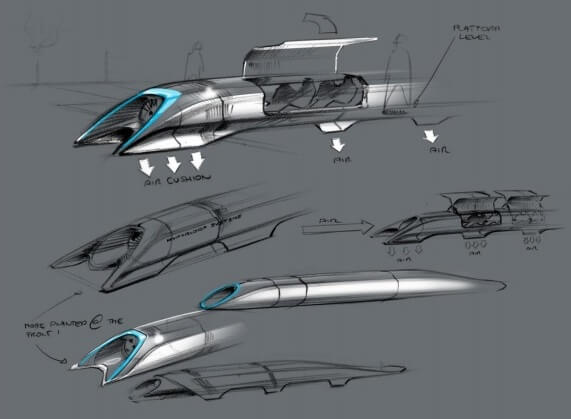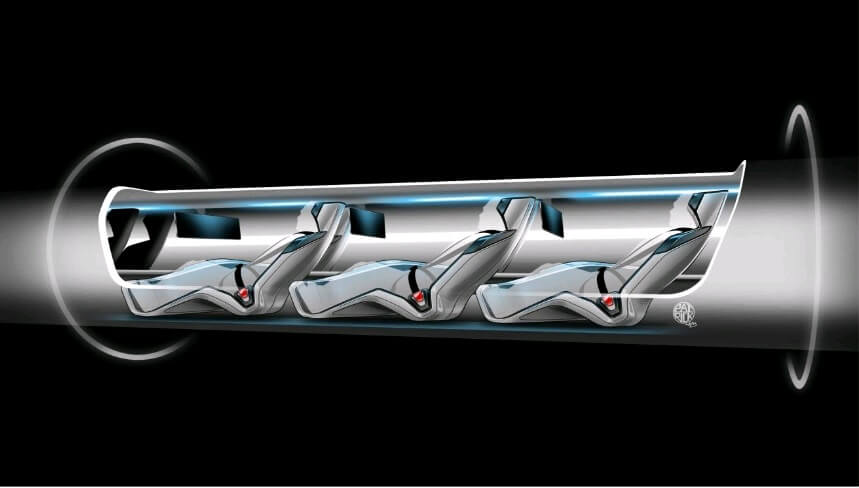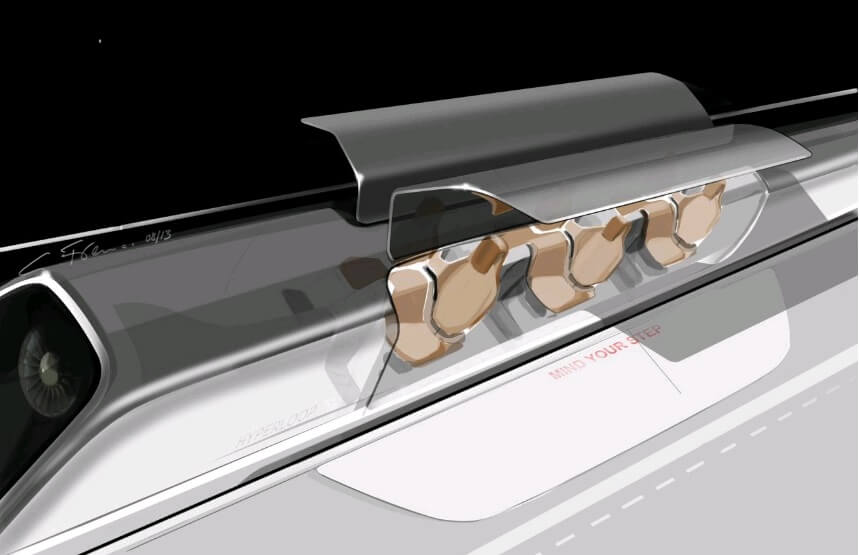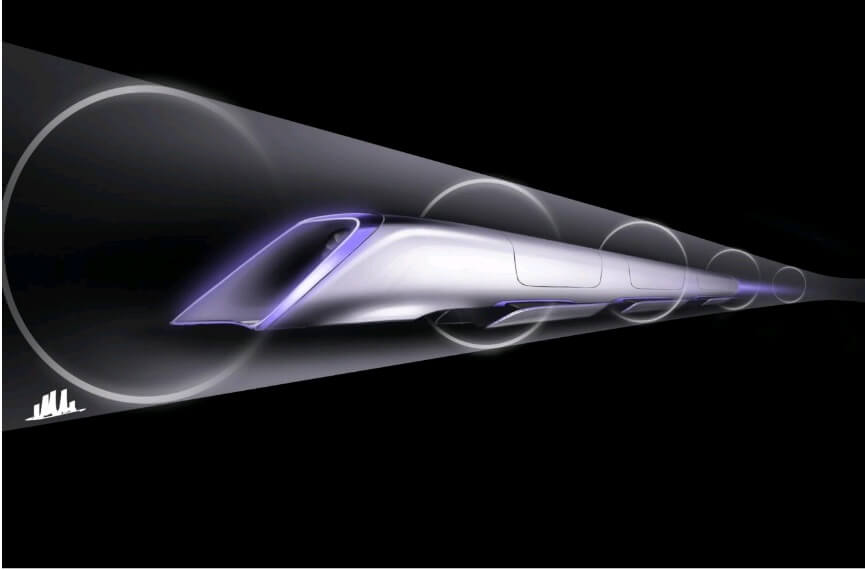A kind of train that travels inside a dedicated tunnel at a speed of 1,200 km/h could enable travel between Los Angeles and San Francisco in half an hour. This is what the founder of SpaceX and the Tesla electric vehicle, the South African billionaire Elon Musk, predicts

By Elizabeth Howell, Universe Today
Yesterday, the founder of SpaceX, the billionaire Elon Musk (who also financed the electric car manufacturer Tesla), published his vision for a futuristic transportation system known as hyperloop. This system is expected to be better than flying at supersonic speed for short distances. This article is a summary of an article published by Musk.
What is hyperloop?
In Musk's words, hyperloop is a system designed to "build a tunnel above or below the ground that will contain a special environment". The cars will move inside this tunnel. One example of this is a type of pneumatic tunnel where fans running at high speed will compress and push the air - because the effects of friction make the Musk doubt that this method will work. Another possibility was to empty the air from the channel and use electromagnetic suspension instead. Matusk comments that it is difficult to maintain a vacuum because there is a small leak in a tunnel hundreds of kilometers long and the system is disabled, but there are pumping solutions that make it possible to overcome this. Therefore he prefers the second solution.
What is the motivation for building such a system?

Photo: Elon Musk/SpaceX/Tesla Motors
Musk is looking for alternatives to flying or driving that could be better than both. He expressed his disappointment that the proposed high-speed rail project in California (between Los Angeles and San Francisco) is relatively slow compared to other high-speed trains in the world and more expensive than them, and estimated that there must be a better way.
What is the biggest technical challenge?
The biggest challenge is the need to overcome a phenomenon known as the Kantarovich limit. Musk describes this as "the law of the ratio between the maximum speed in a certain tunnel and the volume occupied by the projectile." If there is a moving car inside a tunnel filled with air, a minimum distance between the walls of the car and the sides of the tunnel is necessary. Otherwise, writes Musk, the capsule will act like a syringe and in the end it will have to push the entire column of air in the system." Not good.
In Musk's vision, hyperloop systems will be better than the supersonic planes currently planned by several companies, at least for short distances.
How will Musk overcome the challenge?

Photo: Elon Musk/SpaceX/Tesla Motors
Musk's solution is to add an electric compression system to the nose of the capsule so that it pushes the air under high pressure from the front of the capsule to the back side. As a bonus, this will reduce friction. There will still be a need for batteries capable of operating the facility for the entire journey." specified
How will the hyperloop be driven?
According to Musk's calculations, solar collectors placed on the roof of the tunnel will provide enough energy to keep the train moving.
And what about earthquakes?
Musk indicates that a long-term system is vulnerable to earthquakes. "By building the system on columns, when the tunnel is not fixed at any point, the risk of earthquakes can be sharply mitigated and the need to add expansion joints can be avoided." Wrote.
One of Musk's greatest achievements is the construction of a spacecraft, known as Dragon, which makes periodic resupply flights to the International Space Station. Photo: NASA/CSA/Chris Hadfield
Where will hyperloop be used?
In Musk's description, he suggests that the hyperloop will be used in the best way if it is placed between two cities that have a large volume of traffic between them and that are about 1,500 kilometers apart (such as Los Angeles and San Francisco. "For a greater distance it is better to use a supersonic flight. For short distances it is not worthwhile because the plane will spend most of the time taking off or landing."
Is it worthwhile from the economic point of view?

Photo: Elon Musk/SpaceX/Tesla Motors
Musk estimates that the construction of the tunnel will cost several billion dollars, a low amount compared to the tens of billions that the construction of the conventional high-speed train in California will cost. The price of each capsule will also reach several hundred million dollars. Moreover, building a tunnel instead of conventional rails on poles will save expensive land acquisition and there will be no need for fencing.
In this link you can find a comprehensive description of the systemwhich Musk proposes to establish. He calls the system an open source system, and is open to suggestions for its improvement.
* Elizabeth Howell, MSc in Aerospace Engineering is an award-winning freelance writer living in Ottawa, Canada. Besides Universe Today, she also writes for Space.com, the Space Exploration Network and the All About Space website.

12 תגובות
safkan
Woe to science if its purpose were to be useful……
skeptic. You wouldn't approve of Maxwell's equations if they were in your generation. The entire media world and magnetic trains are built on them.
the entire power grid. hydrodynamic nuclear power plants and more. Theoretical research is just as important as applied research.
skeptic:
"I'm not sure he will succeed in building a bullet train at a speed of 1200 km/h, it sounds like a complicated project because of air resistance at this speed" - a stupid sentence.
Where were you when the Wright brothers came up with ideas?
Luckily, everyone who works in the field and knows what they are talking about - thinks differently than you.
I really appreciate Musk or whatever his name is. He is a giant inventor like Edison. I read at the time about his great projects for building spaceships. If I'm not mistaken, his project called Tesla is a winning project among electric cars. I am not sure that he will succeed in building a bullet train at a speed of 1200 km/h, it sounds like a complicated project due to air resistance at this speed, but even if he partially succeeds, he will innovate technologies.
I like people like him who deal with practical problems instead of fruitless preoccupation with broken and unreliable theoretical models. I see the excessive preoccupation with the extreme models of subatomic particles (Higgs particle, etc.) and the big bang models as the decadence of physics; A benefit in the coming centuries will not grow from this.
Ofer, every step you take.
to sparrow,
When do you get to experience g rate acceleration?
to Ofer I have an answer to one of your questions:
To the best of my knowledge, it has been published that the acceleration of the capsule will not exceed 1 G, that is, approximately 10 m per second squared.
At such an acceleration it will take about 35 seconds to reach the maximum speed - 1200 km/h - about 333 meters per second.
We experience 1G acceleration all the time, as you know.
It's really not well written at all, and besides, it's not some idea that hasn't been thought of before. And this does not touch any other issues for example the effect of this type of electrical structure on us (electromagnetic radiation) the effect of the electromagnetic fields on the electrical products we have, telephones and watches for example. The average person's ability to withstand that kind of G-force. and the competitiveness of this type of project compared to other experimental projects and not only what already exists.
Yaffe noted at the beginning of the article that "this article is a summary of an article published by Musk."
But yes, in every sentence you mentioned the name Mosk one more time. In every sentence... it was distressing to read.
You mentioned to the commission that this billionaire wrote everything, there is no need to mention it again and again and again and again...
Besides, it was his concern 🙂
Fascinating but the steering is so bad that it's hard to understand certain sections.